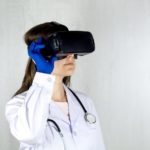 For a technology that has been around for some time, virtual reality has never really “crossed the chasm” into the mainstream, especially outside of the gaming sphere. Nonetheless, there are those who believe it can remain useful. New research from the University of Kent provides such advocacy, with the researchers arguing that VR can prove useful in tackling eating disorders.
For a technology that has been around for some time, virtual reality has never really “crossed the chasm” into the mainstream, especially outside of the gaming sphere. Nonetheless, there are those who believe it can remain useful. New research from the University of Kent provides such advocacy, with the researchers arguing that VR can prove useful in tackling eating disorders.
They argue that Virtual Reality Exposure Therapy (VRET) can be invaluable in improving the impact of remote health appointments for people with eating disorders.
“Multi-User Virtual Reality is an innovative medium for psychotherapeutic interventions that allows for the physical separation of therapist and patient, providing thus more ‘comfortable’ openness by the patients,” the researchers explain. “Exposure to patient worries about body shape and size may exhibit anxious reactions, but through the remote exposure therapy this can elicit new learning that helps the patient to shape new experiences.”
The study saw both therapists and their patients equipped with VR Head-Mounted Displays so they could interact with one another. The patients were allowed to customize their virtual avatar via things such as their hair color, shape, size, and body shape, before they and the therapist were taken into two Virtual Environmental interventions. Here, they had several discussions that ultimately built up to something known as “mirror exposure”.
Virtual mirroring
Mirror exposure is when we’re confronted with an image of our own shape and body. In the virtual reality environment, the participants are pitted face-to-face with the avatars of themselves that they created. They were permitted to modify the avatar, whether in terms of skin tone, clothing, hairstyle, or color. The clothing on the avatar was then gradually removed until it was presented in their virtual underwear.
The participants then had to examine every part of their body and adjust them while describing their thoughts and feelings to the therapist. This provided a virtual exposure therapy that allowed the patient to explore their body via their customized avatar.
The results revealed that the avatar of the therapist was key, as the cartoonish facade helped to create a more open exchange. This mirrors previous research which found virtual communication can aid the discussion of sensitive topics as it reduces any inhibitions participants may have.
“The potential of Virtual Reality being used in addressing health issues with patients, remotely and without the issue of potential judgement, is for VR to be utilised throughout the health sector,” the researchers conclude. “Without the issue of judgement, which people can fear in advance of even seeking medical advice, VR can give people the confidence to engage with and embrace medical advice. In terms of the technical capabilities, the potential for VR to aid in remote non-contact medical appointments between patients and practitioners is huge, due particular consideration in times of pandemic.”